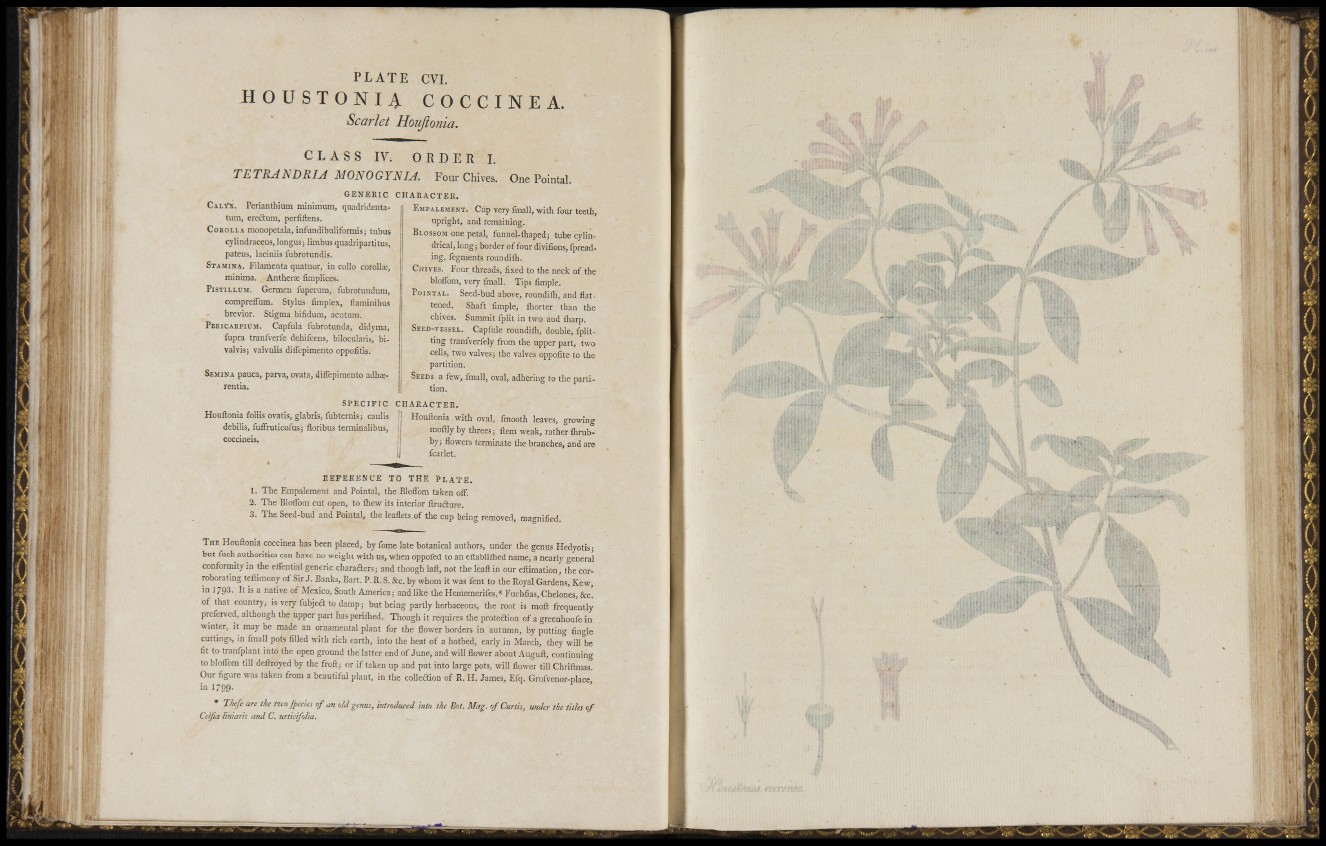
Ü f : Í
/
I
M
i A
P L A T E CVL
H O U S T O N I A COCCINEA.
Scarlet Honjionia.
C L A S S IV. ORDER L
TETRANDRIA MONOGYNU. Four Chives. One Pointal.
C H A R A C T E R .
EMPALEMENT. Cup very fmall, with four teeth,
upright, and remaining.
BLOSSOM one petal, funnel-iliaped; tube cylindrical,
long; border of four divifions, fpreading,
fegnients roundifli.
CmvEs. Four threads, fixed to the neck of the
bloffom, veiy fiiiall. Tips fimple.
P O I N T A L . Seed-bud above, roundilli, and flattened.
Shaft fimple, fhorter than the
chives. Summit fplit in two and fliarp.
SEED-VESSEL. Capfule roundifli, double, fplitting
tranfverfely from the upper part, two
cells, two valves; the valves oppofite to the
partition.
SEEDS a few, fmall, oval, adhering to the partition.
G E N E R I C
CALVX. Perianthium minimum, quadridentatum,
COKOLLA monopetala, infundibuliformis; tubus
cylindraceus, longus; limbus quadripartitus,
patens, laciuiis fubrotundis.
STAMINA. Filamenta quatuor, in collo corolla',
P I S T I L L U M . Germen fuperum, fubrotundum,
comprelTum. Stylus fmiplex, flaminibus
brevior. Stigma bifidum, acutum.
PERICAKPIUM. Capfula fubrotunda, didyma,
fupra tranfverfe dehifcens, bilocularis, bivalvis;
valvulis diirepimento oppofitis.
SEMINA pauca, pan'a, ovata, diffepimento adheelentia.
S P E C I F I C CHARACTEE.
ereiSlum, perfiftens.
minima. Antheras fimplices.
Houftoniafoliis ovatis, glabris, fubternis; caulis ! Houftonia with oval, fmooth leaves, growing
debilis, fufFruticofus; fioribus terminalibus,
coccineis.
moftly by threes; ftem weak, rather ilirubb)';
flowers terminate the branches, and are
fcarlet.
R E F E R E N C E TO THE PLATE.
1. The Empalement and Pointal, the Bloflbm taken off.
2. The Blolfom cut open, to fhew its interior ftruilure.
3. The Seed-bud and Pointal, the leaflets of the cup being removed, magnified.
THE Houftonia coccinea has been placed, by fome late botanical authors, under the genus Hedyotis;
but fuch authorities can have no weight with us, when oppofed to an eftabliflied name, a nearly general
conformity in the eifential generic charaftcrs; and though laft, not the leaft in our efíimation, the corroborating
trftimony of Sir J. Banks, Bart. P. R. S. &c. by whom it was fent to the Royal Gardens, Kew,
in 1793. It is a native of Mexico, South America; and like the Hememerifes,^ Fuchfias, Chelones, &c!
of that country, is very fubjea to damp; but being partly herbaceous, the root is moii frequently
preferved, although the upper part has periflied. Though it requires the proteaion of a greenhoufe in
winter, it may be made an ornamental plant for the flower borders in autumn, by putting Angle
cuttings, in fmall pots filled with rich earth, into the heat of a hotbed, early in March, they will°be
fit to tranfplant into the open ground the latter end of June, and will flower about Auguft, continuing
to bloflbm till deflroyed by the froft; or if taken up and put into large pots, will flov/er till Chriftmast
Our figure was taken from a beautiful plant, in the colleaion of R. H. James, Efq. Grofvenor-place
in 1799-
• Thefe are the iiiv/fecies of an old genus, introduced into the Bot. Mag. of Curtis, under the titles of
Ceijia ¡¡maris and C. urticifolia.
•ip.- •••ifi
¡lVi' i1
I i ." t • '
i. ;
'vii
k ' i1r'' »
f.'
1
4 i
i
II .,iV
• r . l
n !
s>( ; -
if
" M
i • , : ^^
H
: ifi
' f
iî-i ^
• j
. J-I L
• *
• • i i
i
• !Í'
4 - Ï--
k